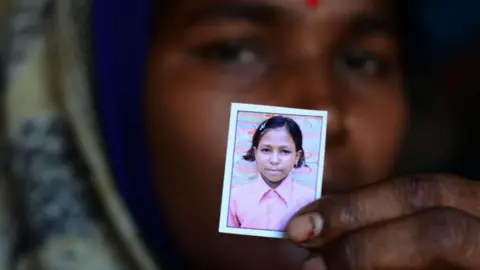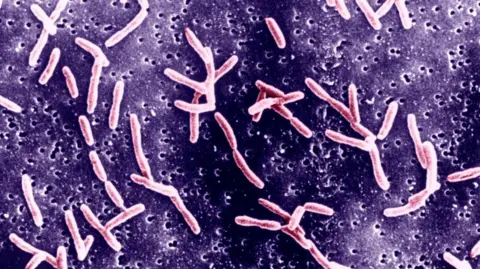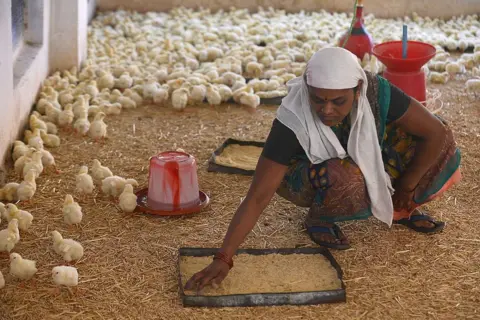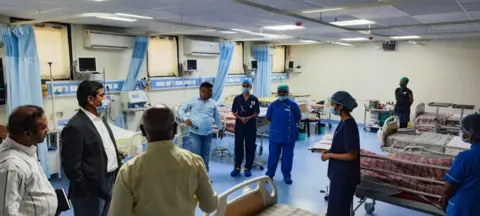Guillain-Barre syndrome: India faces outbreak of creeping paralysis
 Getty Images
Getty ImagesLast month, a school teacher in the western Indian city of Pune found her six-year-old son upset about homework.
"I had erased some words and asked him to write them. I assumed he was angry and that's why he was not holding the pencil properly," she told the Indian Express newspaper.
She never imagined his struggle to hold a pencil was the first sign of Guillain-Barré Syndrome (GBS), a rare disorder where the immune system attacks nerve cells, causing muscle weakness and paralysis.
Within days, the boy was in intensive care, unable to move his arms or legs. As his condition worsened, he lost the ability to swallow, speak, and eventually breathe, requiring ventilator support. He is now recovering.
The boy is among around 160 reported cases of GBS since early January in Pune, an education and IT hub, ringed by industrial towns and villages. There have been five suspected deaths. Currently, 48 patients are in intensive care, 21 on ventilator, and 38 have been discharged, according to official figures.
GBS begins with tingling or numbness in the feet and hands, followed by muscle weakness and difficulty moving joints. Symptoms worsen over two to four weeks, typically starting in the arms and legs. The reported mortality rate varies between three and 13%, depending on severity and quality of health care support.
The outbreak in Pune is being traced to a pathogen called campylobacter jejuni, a leading cause of foodborne infections, and the biggest driver of GBS worldwide. The link between the two was discovered in the 1990s in rural China, where the pathogen was common in chickens, and GBS outbreaks occurred every monsoon as children played in water contaminated by chicken or duck droppings.
 Getty Images
Getty ImagesGBS is not entirely uncommon in India. Monojit Debnath and Madhu Nagappa, of Bangalore-based National Institute of Mental Health and Neurosciences (NIMHANS), studied 150 GBS patients over a five year period between 2014 and 2019.
Their findings showed 79% of the patients had evidence of prior infections, with a third testing positive for campylobacter. Notably, co-infections were more common, occurring in 65%, suggesting a complex interplay of bacteria and viruses.
More recently, outbreaks linked to the pathogen have been reported from all over the world. In the first seven months of 2023, Peru reported over 200 suspected cases and at least four deaths of GBS, prompting the government to declare a national health emergency and strengthen public health measures. Two-thirds of the cases were linked to campylobacter.
In countries with good hygiene, fewer GBS cases are linked to campylobacter, with respiratory infections being a major contributor, say experts. There have been other triggers as well. In 2015 Brazil reported a cluster of GBS cases linked to the Zika virus. Vaccines can rarely trigger GBS, but one Covid vaccine was reportedly linked to a few hundred GBS cases in the UK in 2021.
"Campylobacter is endemic with hundreds of thousands of cases taking place all the time. It is always existing in the environment," Hugh Willison, a professor of neurology at University of Glasgow told me.
Yet, it is not easy to develop GBS, scientists say.
There's a specific strain of campylobacter, which has a sugar-coated outer layer, and in rare cases, its molecular structure matches the coating of human nerve cells.
When the patient's immune system attacks the bacteria, it may end up targeting the nerves as well – a process called molecular mimicry – leading to GBS. However, a small fraction of campylobacter strains have this nerve-like coat.
"In Pune, a strain of campylobacter with this molecular feature is likely to be circulating, and a surge in infections with this strain consequently leads to a higher number of GBS cases," says Prof Willison.
 Getty Images
Getty ImagesMost experts estimate that about one in 100 campylobacter strains carry the GBS risk, and one in 100 people infected with such a strain develop GBS, making the overall risk roughly one in 10,000.
That creates what Prof Willison describes as an "immunological Russian roulette", triggering an "acute neurological tsunami" that surges through the peripheral nervous system. Once the immune response subsides, the attack wanes – but the body still needs time, medical care, and support to repair the damage.
What makes things worse is that there is no cure for GBS.
In GBS, the body produces antibodies against campylobacter, which then attack the nerves. Physicians use "plasma exchange", a process that filters blood to remove the harmful antibodies, along with intravenous immunoglobulin (IVIG), a therapeutic antibody derived from normal blood, to help reduce the severity of the disease.
The other challenge is that there is no single test to diagnose GBS. The diagnosis, say physicians, is mainly based on clinical features. It presents itself as a form of paralysis which can be also caused by polio, viruses or rare neurological disease.
"The diagnosis is a constellation of clinical features. Misdiagnosis or no diagnosis or late diagnosis can happen easily," says Prof Willison.
India's uneven public health system presents a challenge, as doctors in rural areas may struggle to diagnose GBS. One reason, possibly, why the World Health Organization (WHO) teams are in Pune, is collaborating with federal and state health workers to trace, test, and monitor cases, and analysing trends to support effective treatment.
 Pune Municipal Corporation
Pune Municipal CorporationAuthorities say they have surveilled more than 60,000 houses, picked up 160 water samples for tests, and asked people to drink boiled water and eat fresh and clean food, and not have "stale food and partially cooked chicken or mutton".
While most cases of GBS around the world come from undercooked poultry, it can also spread through water, similar to cholera or salmonella, experts say.
Contaminated water used for washing or preparing street food makes it easy for the bacteria to spread. Clearly, in Pune, a campylobacter strain with the distinctive molecular feature is circulating, affecting a large number of people.
What is not clear is whether this has been due to large scale contamination of water supply or a lot of people consuming infected poultry. "We appeal to people not to panic," says a health department advisory. But in the face of uncertainty, it is easier said than done.
